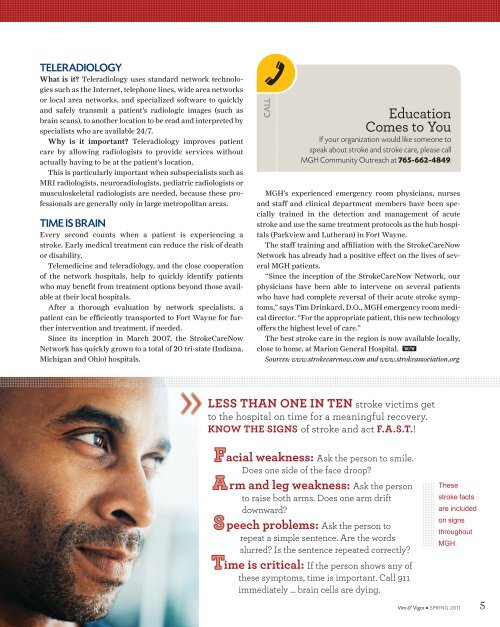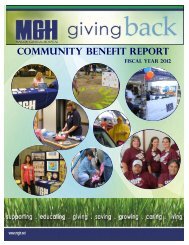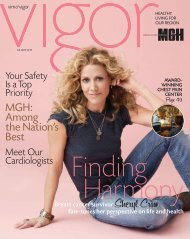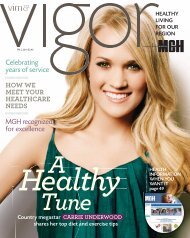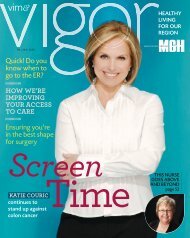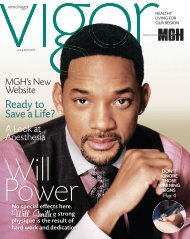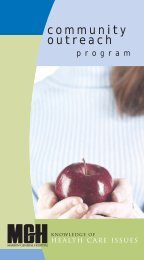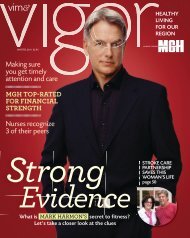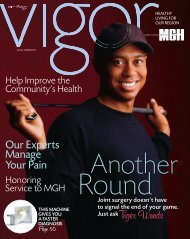vim - Marion General Hospital
vim - Marion General Hospital
vim - Marion General Hospital
You also want an ePaper? Increase the reach of your titles
YUMPU automatically turns print PDFs into web optimized ePapers that Google loves.
TELERADIOLOGY<br />
What is it Teleradiology uses standard network technologies<br />
such as the Internet, telephone lines, wide area networks<br />
or local area networks, and specialized software to quickly<br />
and safely transmit a patient’s radiologic images (such as<br />
brain scans), to another location to be read and interpreted by<br />
specialists who are available 24/7.<br />
Why is it important Teleradiology improves patient<br />
care by allowing radiologists to provide services without<br />
actually having to be at the patient’s location.<br />
This is particularly important when subspecialists such as<br />
MRI radiologists, neuroradiologists, pediatric radiologists or<br />
musculoskeletal radiologists are needed, because these professionals<br />
are generally only in large metropolitan areas.<br />
TIME IS BRAIN<br />
Every second counts when a patient is experiencing a<br />
stroke. Early medical treatment can reduce the risk of death<br />
or disability.<br />
Telemedicine and teleradiology, and the close cooperation<br />
of the network hospitals, help to quickly identify patients<br />
who may benefit from treatment options beyond those available<br />
at their local hospitals.<br />
After a thorough evaluation by network specialists, a<br />
patient can be efficiently transported to Fort Wayne for further<br />
intervention and treatment, if needed.<br />
Since its inception in March 2007, the StrokeCareNow<br />
Network has quickly grown to a total of 20 tri-state (Indiana,<br />
Michigan and Ohio) hospitals.<br />
CALL<br />
Education<br />
Comes to You<br />
If your organization would like someone to<br />
speak about stroke and stroke care, please call<br />
MGH Community Outreach at 765-662-4849.<br />
MGH’s experienced emergency room physicians, nurses<br />
and staff and clinical department members have been specially<br />
trained in the detection and management of acute<br />
stroke and use the same treatment protocols as the hub hospitals<br />
(Parkview and Lutheran) in Fort Wayne.<br />
The staff training and affiliation with the StrokeCareNow<br />
Network has already had a positive effect on the lives of several<br />
MGH patients.<br />
“Since the inception of the StrokeCareNow Network, our<br />
physicians have been able to intervene on several patients<br />
who have had complete reversal of their acute stroke symptoms,”<br />
says Tim Drinkard, D.O., MGH emergency room medical<br />
director. “For the appropriate patient, this new technology<br />
offers the highest level of care.”<br />
The best stroke care in the region is now available locally,<br />
close to home, at <strong>Marion</strong> <strong>General</strong> <strong>Hospital</strong>.<br />
Sources: www.strokecarenow.com and www.strokeassociation.org<br />
LESS THAN ONE IN TEN stroke victims get<br />
to the hospital on time for a meaningful recovery.<br />
KNOW THE SIGNS of stroke and act F.A.S.T.!<br />
Facial weakness: Ask the person to smile.<br />
Does one side of the face droop<br />
A rm and leg weakness: Ask the person<br />
to raise both arms. Does one arm drift<br />
downward<br />
S peech problems: Ask the person to<br />
repeat a simple sentence. Are the words<br />
slurred Is the sentence repeated correctly<br />
Tim e is critical: If the person shows any of<br />
these symptoms, time is important. Call 911<br />
immediately … brain cells are dying.<br />
These<br />
stroke facts<br />
are included<br />
on signs<br />
throughout<br />
MGH.<br />
Vim & Vigor · SPRING 2011 5


